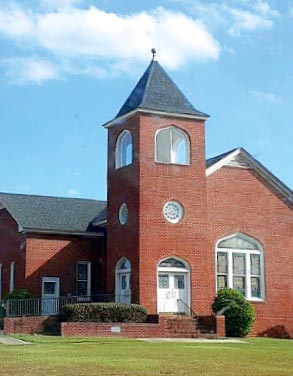
Trinity United Methodist Church, Louisburg, North Carolina
Until now, however, that research was focused on urban sacred places. Partners has suspected that small town and rural churches had an equally important story to tell of civic value and community contribution, and now Partners can begin to affirm that story.
In partnership with the Duke Endowment and UNC Charlotte Urban Institute, Partners conducted a study to better understand the economic impact of rural churches, specifically examining the impact of United Methodist Church (UMC) congregations in North Carolina’s small towns and rural areas. The study examined who benefits from the presence of these congregations and what contributions these churches make to the lifeblood of their communities as conveners, trusted partners, and service providers.
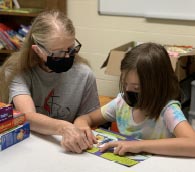
A volunteer helps a young reader through United We Read, a literacy initiative between seven churches, hosted at Prospect United Methodist Church in East Bend. On average, congregations contribute $165,208 in educational benefits and $116,764 in other individual and family impacts each year.
The Rev. Dr. Lauren Anderson
Partners and UNC Charlotte conducted extensive interviews with leaders of 87 rural churches and then monetized and assigned a numerical value to six areas. These areas include direct spending, education and childcare, the spending of visitors in the community, a positive impact on the lives of individuals and families, and community-serving programming.
The study found that Methodist churches are not just for Methodists alone. One of the most important implications of this reality is that civic leaders—including mayors, foundations, business leaders, arts organizations, community groups— should see their churches as places that have a larger public value. The research also showed that:
- Seventy-two percent of those benefiting from programs housed in UMC churches are not members of those congregations. In effect, rural Methodist churches are de facto community centers, just like their sister churches in cities.
- UMC congregations make great economic contributions to their towns and counties, with an average annual contribution to the economy valued at just over $735,000 per congregation. If extrapolated, we might conclude that the 1,283 rural UMCs in North Carolina eligible for Duke Endowment’s Rural Church program generate an overall economic impact of $944 million annually.
- Congregations generate value because they spend locally and hire locally; they host events that bring people to the community who spend money there; they sacrificially share space in their buildings, at low cost or no cost; and they provide needed resources and services to the community.
- Many congregations are community hubs, providing a variety of flexible and affordable space that encourages neighbors to come together to solve problems, serve and be served, and build social capital.
- Congregations are important supporters of early childhood education and provide valuable childcare services in areas underserved by child-care centers. Congregations counsel, support, and make referrals for individuals and families struggling with a range of issues.
- UMCs are also a magnet for visitors, attracting on average, 195 visits to its town or locale each week. Only half of these visits (53%) were for worship activities, while the other half were by individuals attending an event or participating in a program.
The research findings contradict some of the myths that surround rural churches. Too many people believe that rural America and its churches are in decline, but many of the congregations we studied are stable community anchors.
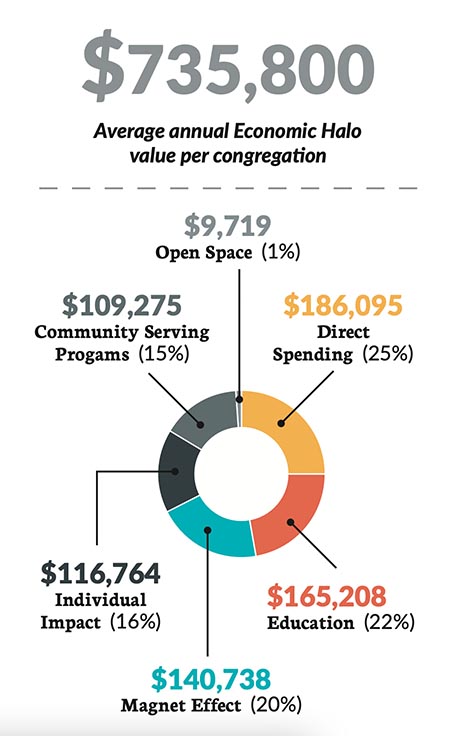 Another myth is that congregations are no longer as relevant to their communities as they once were, but we found that rural congregations do an excellent job of caring for the needs of community members, and are changing to reflect the assets and opportunities around them. Small churches can make a big impact because congregational size and economic impact are not always correlated.
Another myth is that congregations are no longer as relevant to their communities as they once were, but we found that rural congregations do an excellent job of caring for the needs of community members, and are changing to reflect the assets and opportunities around them. Small churches can make a big impact because congregational size and economic impact are not always correlated.
All these findings add up to a larger, remarkable—but little known—reality: UMC congregations, quietly and faithfully, constitute an important part of the fabric of rural communities. We cannot afford to take them for granted. And when they need support, the findings suggest that civic leaders should be more open to giving it.
Congregations provide a wide range of subsidies that support community-serving programs and activities. Offerings include free or below-market space for community groups, events, social services, and education programs, as well as significant hours of volunteer time, in-kind, and cash support. The study showed that 79% of the beneficiaries of community programs and events supported by rural congregations are not members of those congregations.
Implications for Denominations, Government, and Philanthropy
Because both large and small UMCs contribute to the health of rural communities, denominational bodies may want to rethink how they support these congregations. Community impact can serve as an important factor in decision-making about closures and mergers, and raise questions about closures that handicap communities which can ill afford the loss. Before closing any church, we hope that leaders are now in a position to consider the following:
- Is this church making a significant impact in its community?
- Who will be affected if the church is closed, and what programs will be displaced?
- What does the future of this community look like with one or more closed churches?
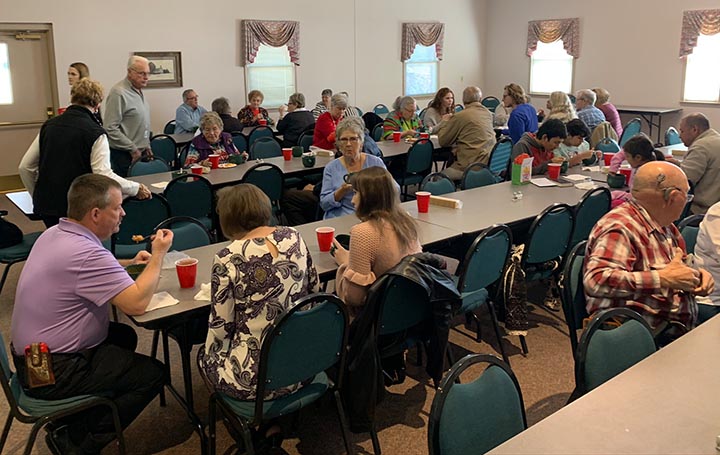
The magnet effect of a rural United Methodist Church—that is, the spending and value that visitors bring to the community when they attend church events throughout the year—is valued at $140,738 annually. Pictured is a fellowship luncheon in the Family Life Center at Prospect UMC. The Rev. Dr. Lauren Anderson
Conversely, congregational impact can be an important input when developing new initiatives or investments in churches. Congregations that are making a significant impact by participating with other non-profits and congregations are especially well positioned to thrive with the right mix of leadership and investment.
There are good reasons for the public sector across North Carolina to take note as well. Rural UMCs are keenly aware of the assets and needs in their communities and are working to provide a “safety net” where government benefits do not suffice. They excel at addressing food insecurity and childcare access, in particular.
- Food programming is almost universal among rural UMCs, which operate and host food pantries; offer regular sit-down meals; and distribute food to local schoolchildren who are in need of supplementary food for nights and weekends.
- Using education wings that once housed Sunday school programs, some operate and rent (usually at below market rates) to early childhood education programs and after-school programs.
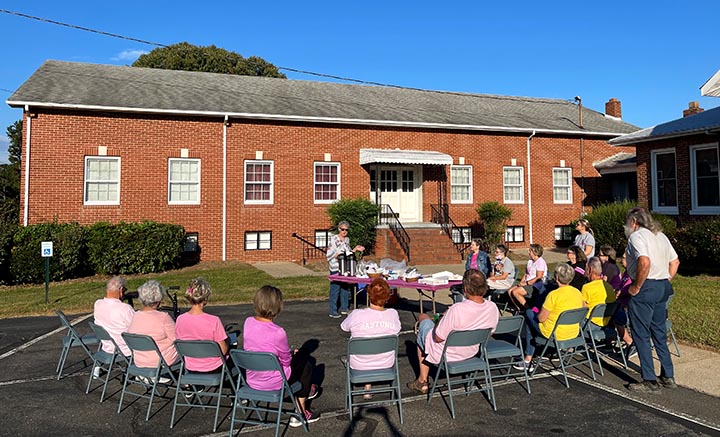
Volunteers at Landers Chapel UMC in Lincolnton, North Carolina gathered at the church for a walk during breast cancer awareness month. The value of a church’s open space to its community and its contributions to local nonprofits are among the components of its Halo Effect.
The Rev. Amy Lambert
When developing programing related to these issues, governments and philanthropic institutions could do more to include congregations. They are trusted community-based institutions with unique insight, they are willing and able to open their doors in partnership with others, and they serve far beyond their membership.

Volunteers prepare meals at Gethsemane United Methodist Church, Greensboro. On average, community serving programs contribute $109,275 each year to their local communities.
The Rev. Sharon T. Lee
Halo patterns can and should help congregations tell their stories to the larger community. Economic Halo Effect data can be used by a congregation to bolster fundraising efforts (especially significant capital campaigns and annual stewardship campaigns), raise the congregation’s profile when shared with civic leaders and local press; and improve congregational morale.
